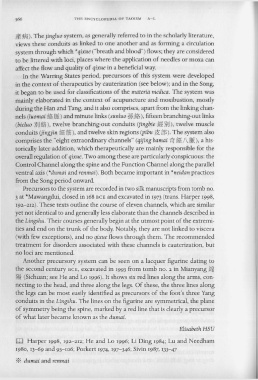Page 608 - The Encyclopedia of Taoism v1_A-L
P. 608
566 TH E ENCYC LO PE DIA O F TAO ISM A- L
Bi ;J~D . The jingluo system, as generally referred to in the scholarly literature,
views these conduits as linked to one another and as forming a circulation
system through which *qixue ("breath and blood") flows; they are considered
to be littered with loci, places where the application of needles or moxa can
affect the flow and quality of qixue in a beneficial way.
In the Warring States period, precursors of this system were developed
in the context of therapeutics by cauterization (see below); and in the Song,
it began to be used for classifications of the materia medica. The system was
mainly elaborated in the context of acupuncture and moxibustion, mostly
during the Han and Tang, and it also comprises, apart from the linking chan-
nels (luomai fo.i& MO and minute links (sunluo t!fo.i&), fifteen branching-out links
(bieluo JJU fo.i&), twelve branching-out conduits (jingbie ~~ JJU), twelve muscle
conduits (jingjin ~~5$), and twelve skin regions (pibu .&:$). The system also
comprises the "eight extraordinary channels" (qijing bamai 1'it~~)\Jlj), a his-
torically later addition, which therapeutically are mainly responsible for the
overall regulation of qixue. Two among these are particularly conspicuous: the
Control Channel along the spine and the Function Channel along the parallel
ventral axis (*dumai and renmai). Both became important in *neidan practices
from the Song period onward.
Precursors to the system are recorded in two silk manuscripts from tomb no.
3 at *Mawangdui, closed in I68 BCE and excavated in I973 (trans. Harper I998,
I92-2I2). These texts outline the course of eleven channels, which are similar
yet not identical to and generally less elaborate than the channels described in
the Lingshu. Their courses generally begin at the utmost point of the extremi-
ties and end on the trunk of the body. Notably, they are not linked to viscera
(with few exceptions), and no qixue flows through them. The recommended
treatment for disorders associated with these channels is cauterization, but
no loci are mentioned.
Another precursory system can be seen on a lacquer figurine dating to
the second century BCE, excavated in I993 from tomb no. 2 in Mianyang ilI1J
IW} (Sichuan; see He and Lo I996). It shows six red lines along the arms, con-
necting to the head, and three along the legs. Of these, the three lines along
the legs can be most easily identified as precursors of the foot's three Yang
conduits in the Lingshu. The lines on the figurine are symmetrical, the plane
of symmetry being the spine, marked by a red line that is clearly a precursor
of what later became known as the dumai.
Elisabeth HSU
III Harper I998, I92-212; He and Lo I996; Li Ding I984; Lu and Needham
I980, I3-69 and 93- I06; Porkert I974, I97-346; Sivin I987, I33- 47
~ dumai and renmai

